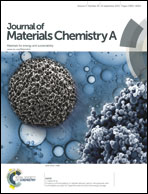Side chain modification: an effective approach to modulate the energy level of benzodithiophene based polymers for high-performance solar cells†
Abstract
Over the past few years, it has been proven that deepening the highest occupied molecular orbital (HOMO) levels of conjugated polymers is one of the most successful strategies to develop novel materials for high performance bulk heterojunction polymer solar cells. Here we report an effective approach of side chain modification in a donor moiety to modulate the highest occupied molecular orbital (HOMO) energy level of benzo[1,2-b:4,5-b′]dithiophene (BDT) based two-dimensional conjugated polymers and hence obtain improved power conversion efficiency. Through the introduction of 2,3-dioctylthienyl groups instead of conventional 2-ethylhexylthienyl groups as side chains in the 4,8-positions of the BDT moiety, four mono-fluorinated quinoxaline based alternating polymers: poly{4,8-di(2-ethylhexylthiophene-5-yl)-2,6-benzo[1,2-b:4,5-b′]dithiophene-alt-5,5-[5′,8′-di-2-thienyl-(6′-fluoro-2′,3′-bis(3′′-octyloxyphenyl)quinoxaline)]} (PBDTTFTQ-EH), poly{4,8-di(2-ethylhexythiophene-5-yl)-2,6-benzo[1,2-b:4,5-b′]dithiophene-alt-5,5-[5′,8′-di-2-thienyl-(6′-fluoro-2′,3′-bis(5′′-octylthiophen-2′′-yl)quinoxaline)]} (PBDTTFTTQ-EH), poly{4,8-di(2,3-dioctylthiophene-5-yl)-2,6-benzo[1,2-b:4,5-b′]dithiophene-alt-5,5-[5′,8′-di-2-thienyl-(6′-fluoro-2′,3′-bis-(3′′-octyloxyphenyl)-quinoxaline)]} (PBDTTFTQ-DO) and poly{4,8-di(2,3-dioctylthiophene-5-yl)-2,6-benzo[1,2-b:4,5-b′]dithiophene-alt-5,5-[5′,8′-di-2-thienyl-(6′-fluoro-2′,3′-bis(5′′-octylthiophen-2′′-yl)quinoxaline)]} (PBDTTFTTQ-DO) were synthesized, in which the former two EH-based polymers contain the 2-ethylhexylthienyl side chain and the latter two DO-based polymers contain the 2,3-dioctylthienyl side chain. The results clearly indicated that the variation in the side chain of the BDT unit from the 2-ethylhexylthienyl group to the 2,3-dioctylthienyl group can cause a deep HOMO level and slightly enlarged bandgap of the polymer. Consequently, polymer solar cells from PBDTTFTQ-DO and PBDTTFTTQ-DO showed high Vocs of 0.88 V and 0.85 V, while those of 0.78 V and 0.72 V were observed in PBDTTFTQ-EH and PBDTTFTTQ-EH based devices, respectively. Both polymers deliver high power conversion efficiency (PCE) exceeding 6.8%, with an outstanding efficiency of 7.61% and an excellent fill factor (FF) of 75.9% for PBDTTFTQ-DO after tetrahydrofuran solvent vapour annealing for 30 s (while a PCE of 7.29% for PBDTTFTQ-EH). Similar results were investigated in PBDTTFTTQ-EH (a PCE of 6.82%) and PBDTTFTTQ-DO (a PCE of 7.25% with high FF of 75.7%) based solar cells. This finding should provide valuable guidelines for the design and synthesis of novel polymer donor materials for highly efficient polymer solar cells via fine tuning of the molecular energy levels and absorption spectra through a modulation of the side chain onto the donor moiety.


 Please wait while we load your content...
Please wait while we load your content...